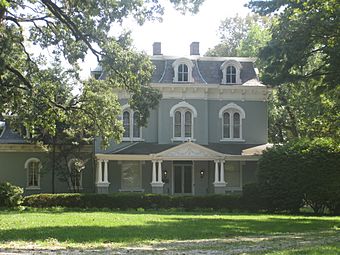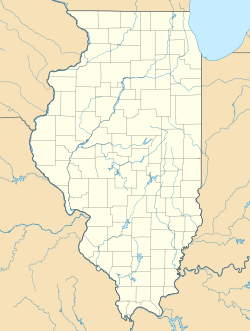Pettengill–Morron House facts for kids
Quick facts for kids |
|
|
Pettengill–Morron House
|
|
 |
|
| Location | 1212 W. Moss Ave. Peoria, Peoria County, Illinois |
|---|---|
| Area | less than one acre |
| Built | 1868 |
| Architect | Charles Ulricson |
| Architectural style | Second Empire |
| NRHP reference No. | 76000724 |
| Added to NRHP | April 2, 1976 |
The Pettengill–Morron House, also known as the Morron House, is a beautiful old mansion in Peoria, Illinois, USA. It's built in a special style called Second Empire. This house is part of the historic Moss-High District in Peoria. It's so important that it's listed on the National Register of Historic Places and is a local landmark for the City of Peoria. Today, you can visit it as a museum run by the Peoria Historical Society.
Contents
The Story of the House
Building a Home in Peoria
The Pettengill–Morron House was first built in 1868. It was made for Moses Pettengill, who owned a hardware store. Moses moved to Peoria from New Hampshire in 1833. When he arrived, Peoria was a very small town. It had only about 150 people. Most homes were log cabins, with just a few made of wood.
Moses and his wife, Lucy, lived in a different home in Peoria from 1836 to 1862. That first home was located where the Peoria Civic Center is now.
A New House Rises
The first house on the current site was built in 1862. It cost $5,000 to build. Sadly, this house was destroyed by a fire on December 13, 1865. After the fire, a new brick house was built in 1868. This new house cost $12,000. It was designed in the Second Empire style, which was popular at the time.
Around 1900, some new parts were added to the house. These included a Colonial Revival style porch and a porte-cochere. A porte-cochere is a covered entrance where people could drive their carriages or cars. The house's address was originally 464 Moss Avenue. In the 1950s, Peoria changed its street numbers.
The Last Resident and Museum
The last person to live in the house was Miss Jean Morron. She lived there from 1953 until she passed away in 1966. The Peoria Historical Society bought the house in 1967. They turned it into a museum so people could learn about its history.
Why This House is Special
National Recognition
The Pettengill–Morron House is very important. It was added to the U.S. National Register of Historic Places on April 2, 1976. This list includes places that are important to the history of the United States. The house is also part of the West Bluff Historic District. This district was added to the National Register in December 1976. In December 2021, the house was also named a City of Peoria Local Historic Landmark. In 2020, the house received money from Landmarks Illinois to help pay for repairs.
A Living Museum
The Peoria Historical Society takes care of the Pettengill–Morron House. They also manage another historic home, the Judge Flanagan Residence. Both are open as historic house museums.
The museum has many items that belonged to the Pettengill family. These items were given by Daisy Peirce Hale, a relative of Moses Pettengill. The collection includes old paintings that have been fixed up and are now displayed in the museum. There is also a diary from Blanchard Pettengill. His diary tells about what it was like growing up in the house on Moss Avenue. Other family records are also kept there.




